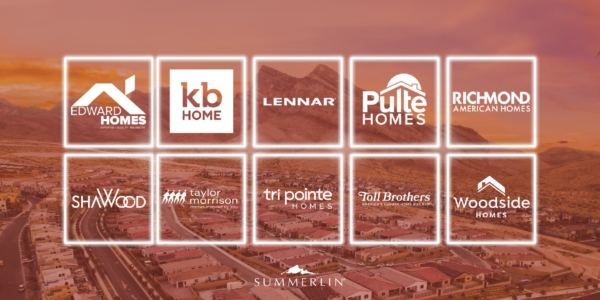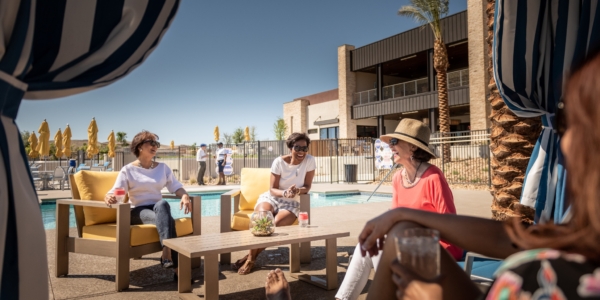Two senior vice presidents of The Howard Hughes Corp., developer of the master-planned community of Summerlin, the retail, dining, entertainment and sports destination of Downtown Summerlin, Las Vegas Ballpark and owner of the Las Vegas Aviators, were recently elected to head two of the valley’s leading development industry organizations.
Brian Walsh, senior vice president of residential for Summerlin, was installed as president of the board of directors, Southern Nevada Homebuilders Association.
Julie Cleaver, senior vice president of planning and design for Summerlin, was recently installed as president of NAIOP Southern Nevada, the region’s leading commercial real estate development association.
According to Kevin T. Orrock, president of Summerlin, while it may seem like a coincidence that two top executives are simultaneously leading the valley’s largest and highest-profile development industry organizations, both Cleaver and Walsh are among the most experienced and insightful leaders in the industry, so their selection to head these associations makes sense.
“Particularly during this time of crisis caused by the global coronavirus pandemic, Julie and Brian are well-positioned to provide the leadership necessary to help their respective organizations move forward and identify strategies and tactics for recovery and doing business in a new world.”
“Julie’s impact on Summerlin, one of the nation’s largest and most successful communities, is profound,” Orrock said. “Since joining HHC in 2005, she has literally shaped how Summerlin looks and unfolds, from architecture to landscape, design and beyond. Her experience is unparalleled. Likewise, Brian joined Summerlin in 2018, bringing with him nearly 40 years of development experience as an engineer for multiple homebuilders, the city of Las Vegas public works department and engineering firms. Together, Brian and Julie are a powerhouse of knowledge.”
Walsh and Cleaver acknowledge that working side-by-side is a distinct advantage that allows them to better collaborate and communicate and develop more synergy as they work to achieve goals for their respective organizations. Particularly, as COVID-19 impacted the world, including the development community, the two executives worked together to help their respective organizations better respond to the pandemic.
According to Cleaver, NAIOP shared SNHBA industry updates on its website, noting that the homebuilding industry boasted timely, up-to-the-minute information on the crisis. And both organizations worked to make donations of significance to help the community, headlined by a $450,000 gift from SNHBA and its members to the Governor’s Task Force on COVID-19, including $100,000 from SNHBA and $50,000 from The Howard Hughes Corp.
Among Cleaver’s top goals for NAIOP Southern Nevada this year is a focus on strengthening relationships with other real estate organizations, including but not limited to SNHBA, CCIM, SIOR, LVGEA, and even government agencies.
“Leadership is also about partnership and providing support to other organizations that share common goals,” Cleaver said. “The federal lands bill supported by Clark County is a great example of how organizations like NAIOP can be difference makers. As the county considers the expansion of the boundary to allow more development, organizations like NAIOP are coming to the table to support the concept and share a cohesive vision with other organizations and municipalities for the future of development in Southern Nevada. Our goal is to strike a balance between ensuring there is room for growth while protecting more environmentally sensitive lands that shouldn’t be developed.”
Cleaver’s second goal for NAIOP is to maximize the CRE Converge 2020 national commercial real estate conference this year. Planned for Oct. 6-8 at Caesars Palace, the colossal convention is hosted by NAIOP Southern Nevada for the third time. The last time the event was held in Las Vegas was 2008, a very different time for our community, she said.
“Over the past 12 years, Las Vegas has changed significantly,” Cleaver said. “The 2020 commercial real estate conference provides an amazing opportunity and platform to showcase our city’s remarkable development story that we are not just the hospitality capital of the world, but also a serious place to do business and a great place to live. From the expanding Convention Center District, Allegiant Stadium, MSG Sphere, Raiders practice facility and Las Vegas Ballpark, our list of new development is stunning. The impact of professional sports and the associated businesses that come with major league sports, puts Las Vegas in a whole different arena. That’s why we are working hard to develop a variety of tours and programs to shout from the rooftops the Las Vegas development story to a captive audience.”
Cleaver’s third goal for NAIOP is to provide leadership opportunities for members to help nurture and foster growth within the commercial development industry. Cleaver cites NAIOP’s Developing Leaders Institute (DLI), a program for those ages 35 years and younger that is now in its 10th year.
Walsh echoes Cleaver’s sentiment about a focus on mentoring future leaders for the homebuilding industry. “A top goal for SNHBA and me, personally, is to ensure high school students know about all the wonderful career opportunities that exist within the industry,” Walsh said.
Another goal for SNHBA this year is to ensure the development of an increasingly wide variety of new home product types via land use zoning and quality development guidelines.
“The ‘white picket fence’ dream of home ownership is evolving,” Walsh said. “Buyers of all generations — from millennials to boomers — are seeking smaller homes with less maintenance to better accommodate experiential lifestyles that include travel and the ability to ‘lock and leave’. That’s why SNHBA is working closely with our local municipalities to ensure development codes that allow for new product types — both move-down as well as move-up. Most importantly, we want to ensure that homes are available valleywide in a variety of price points, including affordable housing.”
If land isn’t affordable, the housing that sits on it can’t be affordable. We also have to make sure construction costs don’t get out of hand. By working collaboratively with other development organizations and local government, hopefully, we can achieve these goals.”














